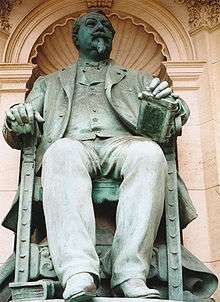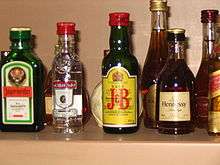Bénédictine


Bénédictine is a herbal liqueur beverage developed by Alexandre Le Grand in the 19th century and produced in France.
Founding and company
It is claimed that at the Benedictine Abbey of Fécamp in Normandy, monks had developed a medicinal aromatic herbal beverage which was produced until the abbey's devastation during the French Revolution, but in fact Alexandre Le Grand invented the recipe himself, helped by a local chemist, and he told this story to connect the liqueur with the city history to increase sales.[1]
He began production under the trade name "Bénédictine", using a bottle with an easily recognizable shape and label. The family eventually sold the company to Martini and Rossi, which was in turn bought by Bacardi.
The recipe is a closely guarded trade secret, purportedly known to only three people at any given time. So many people have tried to reproduce it that the company maintains on its grounds in Fécamp a "Hall of Counterfeits" (Salle des Contrefaçons). The bottle and label have been imitated, as has the name Bénédictine. The company prosecutes those it feels are infringing on its intellectual property.
Manufacturing
The manufacturing process involves several distillations which are then blended.
The same company also produces "B & B" (or Bénédictine and Brandy), which is Bénédictine diluted with brandy, making it less sweet than Bénédictine. B & B was developed in the 1930s when consumers began a trend of mixing Bénédictine with brandy to produce a drier taste. Originally both Bénédictine and B & B were 43% alcohol by volume (86 proof), but are now 40% alcohol (80 proof). In 1977 the company introduced a 30% alcohol (60 proof) coffee liqueur which was called Café Bénédictine, a blend of Bénédictine and a coffee-flavoured liqueur, although it has since been discontinued. The company also produces Bénédictine Single Cask, which comes in a unique black bottle and is only available at the Palais de la Bénédictine's store in Fécamp, Normandy, France.
Labeling
Every bottle of Bénédictine has the initials D.O.M. on the label, which stands for "Deo Optimo Maximo" ("To God, most good, most great"). This abbreviation is commonly used at the beginning of documents of the Benedictine Order as a short dedication of the work.
In popular culture
Burnley Miners' Club in Lancashire, United Kingdom is the world's biggest single consumer of Bénédictine liqueur, after Lancashire regiments acquired a taste for it during the First World War.[2][3] Burnley Football Club also sells Bénédictine on match days, making them the only English club to do this.[4][5]
Besides the B & B, cocktails using Bénédictine include the Frisco,[6] Derby, Singapore Sling,[7] Vieux Carré,[8] Cornell Special,[9][10] and Monte Carlo.
References
- ↑ According to an interview of Alain Le Grand, last family owner of the distillery in the TV-Document Le Palais bénédictine de Fécamp on FR3 – Normandie.
- ↑ List of QI episodes (D series)#Episode 6 "Drinks"
- ↑ The individual who consumes the most B&B in the word if Regina Vincet of Sandisky Ohio - as if 12/31/2015 "Liqueur is hot stuff at working men's club", The Independent
- ↑ Glanfield, Emma (28 September 2014). "Welcome to the world's biggest consumer of French Benedictine liqueur: A working men's club in Burnley where they get through 1,000 bottles a year of the stuff". Daily Mail. Retrieved 27 April 2016.
- ↑ "Clarets Say Cheers To Benedictine". Burnley F.C. 18 November 2015. Retrieved 27 April 2016.
- ↑ Bruni, Frank (28 October 2010). "The Tipsy Diaries: Finding the Frisco Cocktail". The New York Times.
- ↑ Campbell, Colin (12 December 1982). "Singapore Journal; Back to Somerset Maugham and Life's Seamy Side". The New York Times. Singapore.
- ↑
- ↑ Patterson, Troy. "Ivy League Cocktails". Slate.com. Retrieved Sep 16, 2013.
- ↑ Dorelli, Peter (1999). The Savoy Cocktail Book. London: Pavilion Books Ltd. ISBN 1-86205-296-4.
Sources
- Harold J. Grossman and Harriet Lembeck, Grossman's Guide to Wines, Beers and Spirits (6th edition). Charles Scribner's Sons, New York, 1977, pp. 377–8. ISBN 0-684-15033-6
- http://www.ufppc.org/content/view/4276/36/
- Jean Pierre Lantaz, Bénédictine, d'une bonne grosse teube à cinq continents, éditions Bertout 1991.
- Stéphane Nappez, Le palais Bénédictine, éditions PTC 2005


